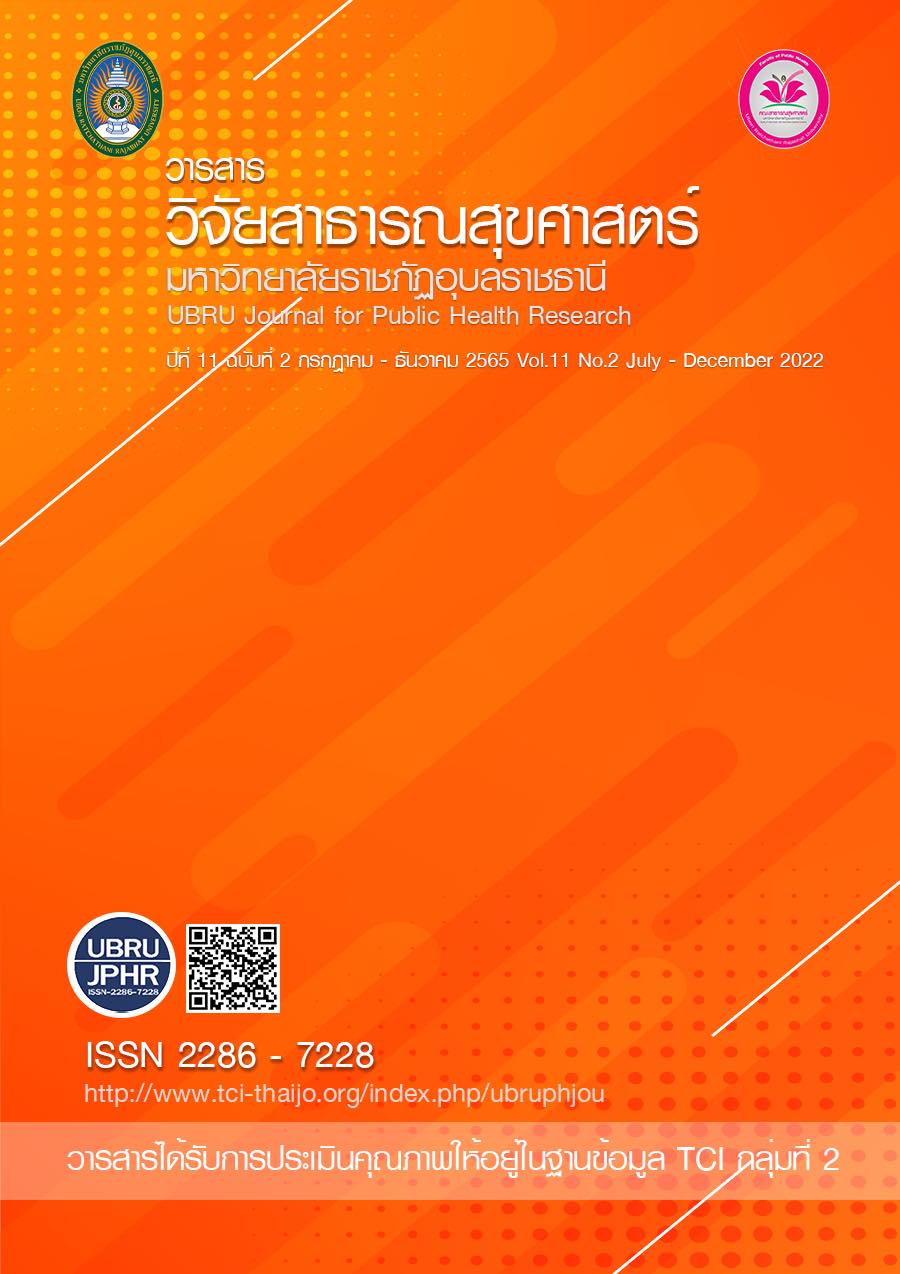The different between ages and self-protection behavior of covid-19, Nakhon Si Thammarat Province
Keywords:
Self-protection behavior, COVID-19, Between AgesAbstract
This cross-sectional descriptive study aimed to 1) explore the self-protection behavior of Covid-19 and 2) the difference between ages and self-protection behavior of Covid-19. The subjects comprised 2,220 people in Nakhon Si Thammarat Province who were chosen through multi-stage sampling. The instrument was a questionnaire that the researcher applied from D-M-H-T-T. The reliability using Cronbach's s alpha coefficient was 0.858. Descriptive statistics, One-way ANOVA, and Fisher's least significant difference test were used to analyze.
The findings revealed that the overall self-protection behavior of Covid-19 was reported at a good level, when separating the measures, it was found that all age groups had a good level of behavior in all aspects. Except people in working age group and teenage group was a moderate level in using application Thai Cha na. In addition, the difference between ages to self-protection behavior of Covid-19 demonstrated that distancing, mask-wearing, Application Thai Cha Na and overall behavior were statistically significant at p- value < 0.05, temperature, testing was statistically significant p- value < 0.01, people in teenage group had the self-protection behavior of Covid-19 less than working age group and elderly group.
Therefore, it is encouraging adolescents to follow the DMHTT measures and raise awareness of the correct behavior. therefore it is important especially the check-in through the application "Thai Chana Because as adolescents grow into adulthood, they will be able to instill the correct behavior.
References
กรมควบคุมโรค กระทรวงสาธารณสุข. (2563). แนวทางการป้องกันและควบคุมโรคไวรัสโคโรนา 2019 สำหรับประชาชน. นนทบุรี
กรมควบคุมโรค กระทรวงสาธารณสุข. (2564). รายงานโรคไวรัสโคโรนา 2019. นนทบุรี.
กรมสุขภาพจิต กระทรวงสาธารณสุข. (2559). องค์ความรู้การดำเนินงานดูแลสุขภาพวัยรุ่นแบบบูรณาการ สำหรับทีมนักจัดการสุขภาพวัยรุ่น. นนทบุรี; บียอนด์ พับลิสซิ่ง จำกัด.
ฉัตรสุมน พฤฒิภิญโญ. (2563). มาตรการการเฝ้าระวัง ป้องกัน และควบคุมโรค การแพร่ระบาดของโควิด-19. วารสารกฎหมายและนโยบายสาธารณสุข, 6(2), 467-485.
ณัฏฐณิชา วรรณมณี, ดารารัตน์ บางพระ, ศุภมาส อยู่อริยะ และจิรพจน์ สังข์ทอง. (2564). ความสัมพันธ์ระหว่างความรู้และการรับรู้กับพฤติกรรมการดำเนินชีวิตแบบวิถีใหม่เพื่อการป้องกันโรคติดเชื้อไวรัสโคโรนา 2019 ของนักศึกษาวิทยาลัยชุมชนสงขลา, การประชุมสวนสุนันทาวิชาการระดับชาติ ครั้งที่ 9 เรื่อง “การยกระดับงานวิจัยสู่นวัตกรรม” มหาวิทยาลัยราชภัฏสวนสุนันทา (Online Conference) วันที่ 17-18 มิถุนายน 2564. มหาวิทยาลัยสวนสุนันทา, กรุงเทพมหานคร.
ณัฎฐวรรณ คำแสน. (2564). ความรู้ ทัศนคติ และพฤติกรรมในการป้องกันตนเองจากการติดเชื้อไวรัสโควิด-19 ของประชาชนในเขตอำเภออู่ทอง จังหวัดสุพรรณบุรี. วารสารวิทยาลัยพยาบาลพระจอมเกล้า จังหวัดเพชรบุรี, 4(4), 33-48.
ณัธภัชร เฉลิมแดน. (2563). พฤติกรรมผู้บริโภคในการสั่งอาหารแบบเดลิเวอรี่ผ่านโมบายแอปพลิเคชัน ช่วงเกิดโรคติดเชื้อไวรัสโคโรนาสายพันธุ์ใหม่ 2019 (COVID-19) ในเขตกรุงเทพมหานคร. วารสารบริหารธุรกิจอุตสาหกรรม, 2(1), 92-106.
ธานี กล่อมใจ จรรยา แก้วใจบุญ ทักษิกา ชัชวรัตน์ (2563). ความรู้และพฤติกรรมของประชาชนเรื่องการป้องกันตนเองจากการติดเชื้อไวรัสโคโรนา
สายพันธุ์ใหม่ 2019. วารสารการพยาบาล การสาธารณสุขและการศึกษา, 21(2), 29-39.
ปุญญพัฒน์ ไชยเมล์. (2556). การกำหนดขนาดตัวอย่างสำหรับการวิจัยเชิงพรรณนาในงานสาธารณสุข. วารสารมหาวิทยาลัยทักษิณ, 16(2), 9-18.
ภัคณัฐ วีรขจร, โชคชัย ขวัญพิชิต, กิตติพร เนาว์สุวรรณ์ แลนภชา สิงห์วีรธรรม. (2563). การรับรู้และพฤติกรรมการป้องกันโรคติดเชื้อไวรัสโคโรนา 2019 (COVID-19) ของกำลังพลที่ปฏิบัติงานสายแพทย์ ศูนย์อำนวยการแพทย์ จังหวัดชายแดนภาคใต้. วารสารสาธารณสุขและวิทยาศาสตร์สุขภาพ, 3(3), 106-117.
รังสรรค์ โฉมยา และกรรณิกา พันธ์ศรี. (2563). ความตระหนักเกี่ยวกับพฤติกรรมการป้องกันการติดต่อโรคไวรัสโคโรนาสายพันธุ์ใหม่ (โควิด-19): การเปรียบเทียบระหว่างวัย. วารสารมนุษยศาสตร์และสังคมศาสตร์ มหาวิทยาลัยมหาสารคาม. 39(6), 71-82.
สำนักงานสาธารณสุขจังหวัดนครศรีธรรมราช กระทรวงสาธารณสุข. (2564). รายงานโรคไวรัสโคโรนา 2019. นครศรีธรรมราช.
สำนักนโยบายและยุทธศาสตร์ สำนักงานปลัดกระทรวงสาธารณสุข กระทรวงสาธารณสุข. (2559). แผนยุทธศาสตร์ชาติ ระยะ 20 ปี (ด้านสาธารณสุข). นนทบุรี.
อภิวดี อินทเจริญ, คันธมาทน์ กาญจนภูมิ, กัลยา ตันสกุล และสุวรรณา ปัตตะพัฒน์. (2564). ปัจจัยที่มีอิทธิพลต่อพฤติกรรมการป้องกันโรคติดเชื้อไวรัสโคโรนา 2019 ของประชาชนในเขตเทศบาลเมืองคอหงส์ จังหวัดสงขลา. วารสารสภาการสาธารณสุขชุมชน, 3(2), 19-30.
BBC NEWS, Robert Cuffe. (2020). Coronavirus death rate: What are the chances of dying ?. England: London.
Best, J.W. (1977). Research in education. 3rded. Englewod cliffs: N.J. Prentice-Hall.
World Health Organization. (2020). Coronavirus. Geneva: World Health Organization.
Downloads
Published
How to Cite
Issue
Section
License
Copyright (c) 2022 คณะสาธารณสุขศาสตร์ มหาวิทยาลัยราชภัฏอุบลราชธานี

This work is licensed under a Creative Commons Attribution-NonCommercial-NoDerivatives 4.0 International License.
เนื้อหาและข้อมูลในบทความที่ลงตีพิมพ์ในวารสารวารสารวิจัยสาธารณสุขศาสตร์ มหาวิทยาลัยราชภัฏอุบลราชธานี ถือเป็นข้อคิดเห็นและความรับผิดชอบของผู้เขียนบทความโดยตรงซึ่งกองบรรณาธิการวารสาร ไม่จำเป็นต้องเห็นด้วย หรือร่วมรับผิดชอบใดๆ
บทความ ข้อมูล เนื้อหา รูปภาพ ฯลฯ ที่ได้รับการตีพิมพ์ในวารสารนี้ ถือเป็นลิขสิทธิ์ของวารสารฯ หากบุคคลหรือหน่วยงานใดต้องการนำทั้งหมดหรือส่วนหนึ่งส่วนใดไปเผยแพร่ต่อหรือเพื่อกระทำการใดๆ จะต้องได้รับอนุญาตเป็นลายลักอักษรณ์จากบรรณาธิการวารสารนี้ก่อนเท่านั้น


